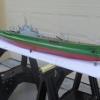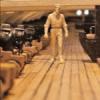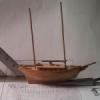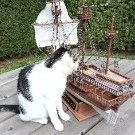Supplies of the Ship Modeler's Handbook are running out. Get your copy NOW before they are gone! Click on photo to order.
×
-
Posts
3,462 -
Joined
-
Last visited
Reputation Activity
-
 amateur got a reaction from Piet in Smit Rotterdam by Sjors - Billing Boats - 1:75 - Sea tug
amateur got a reaction from Piet in Smit Rotterdam by Sjors - Billing Boats - 1:75 - Sea tug
I guess that Smit Rotterdam had those copper coloured props. Still looking for a pic....
(which turned in something else due to heavy use, so: 'do you build 'as new', or 'at the end of her life'.
Here is 'new', unfortunately in BW-photography
Pic found here: http://www.hobbyjan.nl/site/index.php?id=109&pagina=1
jan
-
 amateur got a reaction from popeye the sailor in HMS ROYAL KATHERINE 1664 by Doris - 1/55 - CARD
amateur got a reaction from popeye the sailor in HMS ROYAL KATHERINE 1664 by Doris - 1/55 - CARD
Hi Doris,
I would happily believe anyone that tells me that you fotoshopped a real gun into your last picture Your mastery, not only of card, but also of paint is astonishing.
Jan
(pm to myself: scan the dictionary for more superlatives )
-
 amateur reacted to RGL in SMS Seydlitz by Canute, Cog, Stein Gildberg & RGL - FINISHED - Hobbyboss - 1/350 - PLASTIC
amateur reacted to RGL in SMS Seydlitz by Canute, Cog, Stein Gildberg & RGL - FINISHED - Hobbyboss - 1/350 - PLASTIC
Slowly chipping away at the deck fittings. The ropes down the sides were used for coaling.
-
 amateur got a reaction from dafi in Prins Willem by amateur - Corel - 1:100
amateur got a reaction from dafi in Prins Willem by amateur - Corel - 1:100
No lanterns totday, but plain rope.
I tried to belay some of the lines. Its maddening work: you cant reach the belaying points down the main mast (down teh fore are no belaying points: all lines vanish into the deck). I fear for my ratlines: the ends are coming loose as I get stuck in the shrouds with my fingers or rigginghooks and other helpfull tools.
Mizzen mast: braces of the main topgallant (I did not keep my camera properly upright, no worries, the mast is still the correct way up ) Not very clear picture, but the braces of the cro-jack,attached to the main shrouds, and belayed down the main mast. As my rigging here does quite deviate the Corel-stuff, I was a bit anxious that the braces woud interfere with the backstays, but they are running nice and with sufficient clearance. I'm now puzzling on the braces, sheets and clewlines(?) of the fore and main sail, Corel, Ketting, the original model all show something different, and none of them following the book...... to be continued Jan -
 amateur got a reaction from DORIS in HMS ROYAL KATHERINE 1664 by Doris - 1/55 - CARD
amateur got a reaction from DORIS in HMS ROYAL KATHERINE 1664 by Doris - 1/55 - CARD
Hi Doris,
I would happily believe anyone that tells me that you fotoshopped a real gun into your last picture Your mastery, not only of card, but also of paint is astonishing.
Jan
(pm to myself: scan the dictionary for more superlatives )
-
 amateur got a reaction from Piet in SMS Seydlitz by Canute, Cog, Stein Gildberg & RGL - FINISHED - Hobbyboss - 1/350 - PLASTIC
amateur got a reaction from Piet in SMS Seydlitz by Canute, Cog, Stein Gildberg & RGL - FINISHED - Hobbyboss - 1/350 - PLASTIC
Looking wonderfull.
the booms are around 10 milimeters?
Jan
-
 amateur got a reaction from peveka in Prins Willem by amateur - Corel - 1:100
amateur got a reaction from peveka in Prins Willem by amateur - Corel - 1:100
Hi all,
I need to clean my desk, and to make some pics, but today the unthinkable has happened: I tied the last knot on my rigging.
Now, I need to make some sawdust for the remaining stuff:
I still need:
- guns
- gunport lids (including hinges, rings and ropes)
- lanterns
- anchors
- anchorrope
- anchor buoys
- flags
Not on the home stretch by far....
Jan
-
 amateur got a reaction from cog in Prins Willem by amateur - Corel - 1:100
amateur got a reaction from cog in Prins Willem by amateur - Corel - 1:100
Hi all,
I need to clean my desk, and to make some pics, but today the unthinkable has happened: I tied the last knot on my rigging.
Now, I need to make some sawdust for the remaining stuff:
I still need:
- guns
- gunport lids (including hinges, rings and ropes)
- lanterns
- anchors
- anchorrope
- anchor buoys
- flags
Not on the home stretch by far....
Jan
-
 amateur reacted to YankeeD in De Zeven Provinciën 1665 by YankeeD - Scale 1:50 - according to drawings by Mr. O. Blom - First wooden scratch ship build
amateur reacted to YankeeD in De Zeven Provinciën 1665 by YankeeD - Scale 1:50 - according to drawings by Mr. O. Blom - First wooden scratch ship build
Hi all, (do not want to be gender specific....;))
I have returned to the hobby again after a full recovery of my hand. Thanks for all the good whishes.
Just waiting to get the right hand done, but that will be spring somewhere. not just yet...
I have started redoing the rudder as said. I am using mainly the method used by Drazen (Thanks for that!) I think the photo's are mostly self explanatory. Its a slow learning curve but I like it very much although progress is slow.
I made the rudded out of seperate parts of wood, taking care of the grain direction as to prevent as much as possible deformation. And I decided to do the hinges also from scratch. Previously I used Amati hinges.
I
In the background the Amati hinges from the previous rudder.
I had a big problem blackening the parts. I left them much too long in the solution and 2 were totally 'eaten' away. I did 4 pieces again.
I on purpose made the bolting a little out of line. I like the looking of this.
And now up to the counter part. I hope to finish today.
-
 amateur got a reaction from Baker in HMS ROYAL KATHERINE 1664 by Doris - 1/55 - CARD
amateur got a reaction from Baker in HMS ROYAL KATHERINE 1664 by Doris - 1/55 - CARD
Hi Doris,
I would happily believe anyone that tells me that you fotoshopped a real gun into your last picture Your mastery, not only of card, but also of paint is astonishing.
Jan
(pm to myself: scan the dictionary for more superlatives )
-
 amateur reacted to Ondras71 in Roter Löwe 1597 by Ondras71
amateur reacted to Ondras71 in Roter Löwe 1597 by Ondras71
The deck, repaired, now looks more realistic..👌
As a reminder, here is the old version.. -
 amateur got a reaction from pirozzi in New here. Possibly in over my head.
amateur got a reaction from pirozzi in New here. Possibly in over my head.
Don't panic: it is like a lego box, but a slightly more complicated one
Buying second hand is a bit of a risk: the box already being opened can result in either missing, or damaged parts.
Buying a kit that is already started, is also a risk: you start out with the problems an other person made.
Having siad that:
step 1: check the contents of the box (check it against the instruction booklet, which I hope is there, otherwise you have a BIG chalenge)
step 2: read the instruction booklet (not hust the first step, but all of it, at least twice). You can also do this as step 0
Step 3: try to imagine where everything has to go (more or less)
step 4 buy you some basic tools and materials.
a small hammer, couple of pins (you know the long shapr ones, the missus uses when creating a new dress). Clothing peggs can be usefull as well as clamps. Buy something like a couple of sharp knives (the X-acto will do, don't forget the spare blades, as you will snap and damage a couple when going along).
for glue: white wood glue, gives you plenty of grip, and plenty of correction time.
Some modellersfiles (not the heavy metal workers version), and sandpaper (course and fine).
Accept the fact that you will come to the point that your tools don't suffice, and buy when needed. No need to set up a full scale modellers workshop before starting your first.
Don't set your standards too high. I don't know what you paid for this kit, but be prepared to think "ah well, it was only just for fun, and I had some fun trying". The 'next will be better thought' will never leave you, however high quality you will ever reach
With respect to the model itself: it looks as if the frames are already glued to the keel. If so, make sure that the keel is straight, and than the frames are perpendicular to the keel.
And then you are off, onto a whole new road: read the booklet, and sees what comes next.
Remeber: it is very tempting to do things not in the order the booklet shows, but they are there (probably) for a reason. In all cases: don't forget to think ahead. What comes next, and how am I going to do it.
In case of doubt or emergency: stop working, and give us a shout and a picture.
Jan
-
 amateur got a reaction from popeye the sailor in SMS Seydlitz by Canute, Cog, Stein Gildberg & RGL - FINISHED - Hobbyboss - 1/350 - PLASTIC
amateur got a reaction from popeye the sailor in SMS Seydlitz by Canute, Cog, Stein Gildberg & RGL - FINISHED - Hobbyboss - 1/350 - PLASTIC
Looking wonderfull.
the booms are around 10 milimeters?
Jan
-
 amateur got a reaction from Piet in HMS ROYAL KATHERINE 1664 by Doris - 1/55 - CARD
amateur got a reaction from Piet in HMS ROYAL KATHERINE 1664 by Doris - 1/55 - CARD
Hi Doris,
I would happily believe anyone that tells me that you fotoshopped a real gun into your last picture Your mastery, not only of card, but also of paint is astonishing.
Jan
(pm to myself: scan the dictionary for more superlatives )
-
 amateur got a reaction from mtaylor in HMS ROYAL KATHERINE 1664 by Doris - 1/55 - CARD
amateur got a reaction from mtaylor in HMS ROYAL KATHERINE 1664 by Doris - 1/55 - CARD
Hi Doris,
I would happily believe anyone that tells me that you fotoshopped a real gun into your last picture Your mastery, not only of card, but also of paint is astonishing.
Jan
(pm to myself: scan the dictionary for more superlatives )
-
 amateur reacted to Hubac's Historian in Cracking of wood due to strong humidity deviations – need help
amateur reacted to Hubac's Historian in Cracking of wood due to strong humidity deviations – need help
Okay, so it seems as though the degree of tangential shrinkage of your lime wood substrate is the culprit here. The cracking appears most prominent, along the centerline of the ship, where the lime is pulling away from the central keel former and causing the plywood, there, to split along its laminations. Your planking strakes show irregular gapping and cracking because they are alternately fixed to the shrinking lime and the stable plywood bulkheads. So, that’s a description of the problem.
It’s a bit surprising that you are seeing this degree of shrinkage, given how dry the lime was when you first glued it in. You mention that, at one point in your early build, there was some flooding in the basement that damaged the work surface, but not the model. Did the model get even a little wet?
Anyway, as for fixing the problem - I agree with the advice of Vossie and others that you are going to need to regulate the humidity, to the degree that the cracks close up again.
Personally, I would remove the cracked planks that will never be sufficiently “repaired,” so that I could get a better read on the substrate to know when the cracks had truly closed.
Once you have done so, and stabilized the hull, I would think about injecting some thin cyano (or perhaps there’s a better adhesive for the application?) into the crack faults - particularly along the central bulkhead former. You might also consider marking the path of the cracks with pencil, in the event that they close so completely, that you can’t reliably find them for your injections.
Once you are satisfied that you have stabilized movement, I think it would be safe to go ahead and make repairs.
I feel for you, Drazen. This is one of my favorite models on MSW. I think it is fixable, just a bit of a bear to set things to right, again.
-
 amateur reacted to Vegaskip in Ship paintings
amateur reacted to Vegaskip in Ship paintings
I was asked if I could put up a 'How I do it' series
here it is hope it helps
jim
-
 amateur got a reaction from CaptainSteve in New here. Possibly in over my head.
amateur got a reaction from CaptainSteve in New here. Possibly in over my head.
Don't panic: it is like a lego box, but a slightly more complicated one
Buying second hand is a bit of a risk: the box already being opened can result in either missing, or damaged parts.
Buying a kit that is already started, is also a risk: you start out with the problems an other person made.
Having siad that:
step 1: check the contents of the box (check it against the instruction booklet, which I hope is there, otherwise you have a BIG chalenge)
step 2: read the instruction booklet (not hust the first step, but all of it, at least twice). You can also do this as step 0
Step 3: try to imagine where everything has to go (more or less)
step 4 buy you some basic tools and materials.
a small hammer, couple of pins (you know the long shapr ones, the missus uses when creating a new dress). Clothing peggs can be usefull as well as clamps. Buy something like a couple of sharp knives (the X-acto will do, don't forget the spare blades, as you will snap and damage a couple when going along).
for glue: white wood glue, gives you plenty of grip, and plenty of correction time.
Some modellersfiles (not the heavy metal workers version), and sandpaper (course and fine).
Accept the fact that you will come to the point that your tools don't suffice, and buy when needed. No need to set up a full scale modellers workshop before starting your first.
Don't set your standards too high. I don't know what you paid for this kit, but be prepared to think "ah well, it was only just for fun, and I had some fun trying". The 'next will be better thought' will never leave you, however high quality you will ever reach
With respect to the model itself: it looks as if the frames are already glued to the keel. If so, make sure that the keel is straight, and than the frames are perpendicular to the keel.
And then you are off, onto a whole new road: read the booklet, and sees what comes next.
Remeber: it is very tempting to do things not in the order the booklet shows, but they are there (probably) for a reason. In all cases: don't forget to think ahead. What comes next, and how am I going to do it.
In case of doubt or emergency: stop working, and give us a shout and a picture.
Jan
-
 amateur got a reaction from JeffT in New here. Possibly in over my head.
amateur got a reaction from JeffT in New here. Possibly in over my head.
Don't panic: it is like a lego box, but a slightly more complicated one
Buying second hand is a bit of a risk: the box already being opened can result in either missing, or damaged parts.
Buying a kit that is already started, is also a risk: you start out with the problems an other person made.
Having siad that:
step 1: check the contents of the box (check it against the instruction booklet, which I hope is there, otherwise you have a BIG chalenge)
step 2: read the instruction booklet (not hust the first step, but all of it, at least twice). You can also do this as step 0
Step 3: try to imagine where everything has to go (more or less)
step 4 buy you some basic tools and materials.
a small hammer, couple of pins (you know the long shapr ones, the missus uses when creating a new dress). Clothing peggs can be usefull as well as clamps. Buy something like a couple of sharp knives (the X-acto will do, don't forget the spare blades, as you will snap and damage a couple when going along).
for glue: white wood glue, gives you plenty of grip, and plenty of correction time.
Some modellersfiles (not the heavy metal workers version), and sandpaper (course and fine).
Accept the fact that you will come to the point that your tools don't suffice, and buy when needed. No need to set up a full scale modellers workshop before starting your first.
Don't set your standards too high. I don't know what you paid for this kit, but be prepared to think "ah well, it was only just for fun, and I had some fun trying". The 'next will be better thought' will never leave you, however high quality you will ever reach
With respect to the model itself: it looks as if the frames are already glued to the keel. If so, make sure that the keel is straight, and than the frames are perpendicular to the keel.
And then you are off, onto a whole new road: read the booklet, and sees what comes next.
Remeber: it is very tempting to do things not in the order the booklet shows, but they are there (probably) for a reason. In all cases: don't forget to think ahead. What comes next, and how am I going to do it.
In case of doubt or emergency: stop working, and give us a shout and a picture.
Jan
-
 amateur got a reaction from mtaylor in New here. Possibly in over my head.
amateur got a reaction from mtaylor in New here. Possibly in over my head.
Don't panic: it is like a lego box, but a slightly more complicated one
Buying second hand is a bit of a risk: the box already being opened can result in either missing, or damaged parts.
Buying a kit that is already started, is also a risk: you start out with the problems an other person made.
Having siad that:
step 1: check the contents of the box (check it against the instruction booklet, which I hope is there, otherwise you have a BIG chalenge)
step 2: read the instruction booklet (not hust the first step, but all of it, at least twice). You can also do this as step 0
Step 3: try to imagine where everything has to go (more or less)
step 4 buy you some basic tools and materials.
a small hammer, couple of pins (you know the long shapr ones, the missus uses when creating a new dress). Clothing peggs can be usefull as well as clamps. Buy something like a couple of sharp knives (the X-acto will do, don't forget the spare blades, as you will snap and damage a couple when going along).
for glue: white wood glue, gives you plenty of grip, and plenty of correction time.
Some modellersfiles (not the heavy metal workers version), and sandpaper (course and fine).
Accept the fact that you will come to the point that your tools don't suffice, and buy when needed. No need to set up a full scale modellers workshop before starting your first.
Don't set your standards too high. I don't know what you paid for this kit, but be prepared to think "ah well, it was only just for fun, and I had some fun trying". The 'next will be better thought' will never leave you, however high quality you will ever reach
With respect to the model itself: it looks as if the frames are already glued to the keel. If so, make sure that the keel is straight, and than the frames are perpendicular to the keel.
And then you are off, onto a whole new road: read the booklet, and sees what comes next.
Remeber: it is very tempting to do things not in the order the booklet shows, but they are there (probably) for a reason. In all cases: don't forget to think ahead. What comes next, and how am I going to do it.
In case of doubt or emergency: stop working, and give us a shout and a picture.
Jan
-
 amateur got a reaction from Keith Black in New here. Possibly in over my head.
amateur got a reaction from Keith Black in New here. Possibly in over my head.
Don't panic: it is like a lego box, but a slightly more complicated one
Buying second hand is a bit of a risk: the box already being opened can result in either missing, or damaged parts.
Buying a kit that is already started, is also a risk: you start out with the problems an other person made.
Having siad that:
step 1: check the contents of the box (check it against the instruction booklet, which I hope is there, otherwise you have a BIG chalenge)
step 2: read the instruction booklet (not hust the first step, but all of it, at least twice). You can also do this as step 0
Step 3: try to imagine where everything has to go (more or less)
step 4 buy you some basic tools and materials.
a small hammer, couple of pins (you know the long shapr ones, the missus uses when creating a new dress). Clothing peggs can be usefull as well as clamps. Buy something like a couple of sharp knives (the X-acto will do, don't forget the spare blades, as you will snap and damage a couple when going along).
for glue: white wood glue, gives you plenty of grip, and plenty of correction time.
Some modellersfiles (not the heavy metal workers version), and sandpaper (course and fine).
Accept the fact that you will come to the point that your tools don't suffice, and buy when needed. No need to set up a full scale modellers workshop before starting your first.
Don't set your standards too high. I don't know what you paid for this kit, but be prepared to think "ah well, it was only just for fun, and I had some fun trying". The 'next will be better thought' will never leave you, however high quality you will ever reach
With respect to the model itself: it looks as if the frames are already glued to the keel. If so, make sure that the keel is straight, and than the frames are perpendicular to the keel.
And then you are off, onto a whole new road: read the booklet, and sees what comes next.
Remeber: it is very tempting to do things not in the order the booklet shows, but they are there (probably) for a reason. In all cases: don't forget to think ahead. What comes next, and how am I going to do it.
In case of doubt or emergency: stop working, and give us a shout and a picture.
Jan
-
 amateur got a reaction from russ in New here. Possibly in over my head.
amateur got a reaction from russ in New here. Possibly in over my head.
Don't panic: it is like a lego box, but a slightly more complicated one
Buying second hand is a bit of a risk: the box already being opened can result in either missing, or damaged parts.
Buying a kit that is already started, is also a risk: you start out with the problems an other person made.
Having siad that:
step 1: check the contents of the box (check it against the instruction booklet, which I hope is there, otherwise you have a BIG chalenge)
step 2: read the instruction booklet (not hust the first step, but all of it, at least twice). You can also do this as step 0
Step 3: try to imagine where everything has to go (more or less)
step 4 buy you some basic tools and materials.
a small hammer, couple of pins (you know the long shapr ones, the missus uses when creating a new dress). Clothing peggs can be usefull as well as clamps. Buy something like a couple of sharp knives (the X-acto will do, don't forget the spare blades, as you will snap and damage a couple when going along).
for glue: white wood glue, gives you plenty of grip, and plenty of correction time.
Some modellersfiles (not the heavy metal workers version), and sandpaper (course and fine).
Accept the fact that you will come to the point that your tools don't suffice, and buy when needed. No need to set up a full scale modellers workshop before starting your first.
Don't set your standards too high. I don't know what you paid for this kit, but be prepared to think "ah well, it was only just for fun, and I had some fun trying". The 'next will be better thought' will never leave you, however high quality you will ever reach
With respect to the model itself: it looks as if the frames are already glued to the keel. If so, make sure that the keel is straight, and than the frames are perpendicular to the keel.
And then you are off, onto a whole new road: read the booklet, and sees what comes next.
Remeber: it is very tempting to do things not in the order the booklet shows, but they are there (probably) for a reason. In all cases: don't forget to think ahead. What comes next, and how am I going to do it.
In case of doubt or emergency: stop working, and give us a shout and a picture.
Jan
-
 amateur got a reaction from tarbrush in New here. Possibly in over my head.
amateur got a reaction from tarbrush in New here. Possibly in over my head.
Don't panic: it is like a lego box, but a slightly more complicated one
Buying second hand is a bit of a risk: the box already being opened can result in either missing, or damaged parts.
Buying a kit that is already started, is also a risk: you start out with the problems an other person made.
Having siad that:
step 1: check the contents of the box (check it against the instruction booklet, which I hope is there, otherwise you have a BIG chalenge)
step 2: read the instruction booklet (not hust the first step, but all of it, at least twice). You can also do this as step 0
Step 3: try to imagine where everything has to go (more or less)
step 4 buy you some basic tools and materials.
a small hammer, couple of pins (you know the long shapr ones, the missus uses when creating a new dress). Clothing peggs can be usefull as well as clamps. Buy something like a couple of sharp knives (the X-acto will do, don't forget the spare blades, as you will snap and damage a couple when going along).
for glue: white wood glue, gives you plenty of grip, and plenty of correction time.
Some modellersfiles (not the heavy metal workers version), and sandpaper (course and fine).
Accept the fact that you will come to the point that your tools don't suffice, and buy when needed. No need to set up a full scale modellers workshop before starting your first.
Don't set your standards too high. I don't know what you paid for this kit, but be prepared to think "ah well, it was only just for fun, and I had some fun trying". The 'next will be better thought' will never leave you, however high quality you will ever reach
With respect to the model itself: it looks as if the frames are already glued to the keel. If so, make sure that the keel is straight, and than the frames are perpendicular to the keel.
And then you are off, onto a whole new road: read the booklet, and sees what comes next.
Remeber: it is very tempting to do things not in the order the booklet shows, but they are there (probably) for a reason. In all cases: don't forget to think ahead. What comes next, and how am I going to do it.
In case of doubt or emergency: stop working, and give us a shout and a picture.
Jan
-
 amateur got a reaction from Baker in New here. Possibly in over my head.
amateur got a reaction from Baker in New here. Possibly in over my head.
Don't panic: it is like a lego box, but a slightly more complicated one
Buying second hand is a bit of a risk: the box already being opened can result in either missing, or damaged parts.
Buying a kit that is already started, is also a risk: you start out with the problems an other person made.
Having siad that:
step 1: check the contents of the box (check it against the instruction booklet, which I hope is there, otherwise you have a BIG chalenge)
step 2: read the instruction booklet (not hust the first step, but all of it, at least twice). You can also do this as step 0
Step 3: try to imagine where everything has to go (more or less)
step 4 buy you some basic tools and materials.
a small hammer, couple of pins (you know the long shapr ones, the missus uses when creating a new dress). Clothing peggs can be usefull as well as clamps. Buy something like a couple of sharp knives (the X-acto will do, don't forget the spare blades, as you will snap and damage a couple when going along).
for glue: white wood glue, gives you plenty of grip, and plenty of correction time.
Some modellersfiles (not the heavy metal workers version), and sandpaper (course and fine).
Accept the fact that you will come to the point that your tools don't suffice, and buy when needed. No need to set up a full scale modellers workshop before starting your first.
Don't set your standards too high. I don't know what you paid for this kit, but be prepared to think "ah well, it was only just for fun, and I had some fun trying". The 'next will be better thought' will never leave you, however high quality you will ever reach
With respect to the model itself: it looks as if the frames are already glued to the keel. If so, make sure that the keel is straight, and than the frames are perpendicular to the keel.
And then you are off, onto a whole new road: read the booklet, and sees what comes next.
Remeber: it is very tempting to do things not in the order the booklet shows, but they are there (probably) for a reason. In all cases: don't forget to think ahead. What comes next, and how am I going to do it.
In case of doubt or emergency: stop working, and give us a shout and a picture.
Jan
-
 amateur got a reaction from Katoom in New here. Possibly in over my head.
amateur got a reaction from Katoom in New here. Possibly in over my head.
Don't panic: it is like a lego box, but a slightly more complicated one
Buying second hand is a bit of a risk: the box already being opened can result in either missing, or damaged parts.
Buying a kit that is already started, is also a risk: you start out with the problems an other person made.
Having siad that:
step 1: check the contents of the box (check it against the instruction booklet, which I hope is there, otherwise you have a BIG chalenge)
step 2: read the instruction booklet (not hust the first step, but all of it, at least twice). You can also do this as step 0
Step 3: try to imagine where everything has to go (more or less)
step 4 buy you some basic tools and materials.
a small hammer, couple of pins (you know the long shapr ones, the missus uses when creating a new dress). Clothing peggs can be usefull as well as clamps. Buy something like a couple of sharp knives (the X-acto will do, don't forget the spare blades, as you will snap and damage a couple when going along).
for glue: white wood glue, gives you plenty of grip, and plenty of correction time.
Some modellersfiles (not the heavy metal workers version), and sandpaper (course and fine).
Accept the fact that you will come to the point that your tools don't suffice, and buy when needed. No need to set up a full scale modellers workshop before starting your first.
Don't set your standards too high. I don't know what you paid for this kit, but be prepared to think "ah well, it was only just for fun, and I had some fun trying". The 'next will be better thought' will never leave you, however high quality you will ever reach
With respect to the model itself: it looks as if the frames are already glued to the keel. If so, make sure that the keel is straight, and than the frames are perpendicular to the keel.
And then you are off, onto a whole new road: read the booklet, and sees what comes next.
Remeber: it is very tempting to do things not in the order the booklet shows, but they are there (probably) for a reason. In all cases: don't forget to think ahead. What comes next, and how am I going to do it.
In case of doubt or emergency: stop working, and give us a shout and a picture.
Jan
















